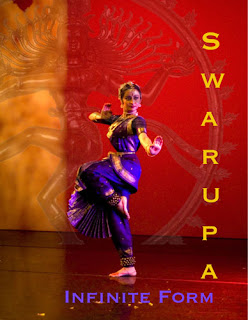Performing the Border was an evening of dance built on the grammar of two Indian classical dance forms, Bharatnatyam and Odissi, as well as modern dance vocabulary. This collaboration between Dakshina, a Bharatnatyam and modern dance company, and Sakshi Productions, a neo-classical and contemporary Odissi dance company, explored the borders that separate dance histories and vocabularies, the classical from the modern, as well as dancers from their audience.
The program began with Pushpanjali, a Bharatnatyam choreography in which the dancers offered flowers as an invocation to the gods. The five dancers of Dakshina exhibited perfection in their movements, synchronization, and formations. I overheard one of the other members of the audience describe the piece as 'cute'. I thought the bright blue and green costumes looked fantastic on stage.
The second presentation was Arabi Pallavi, an Odissi choreography based on a raga that builds in rhythm, speed and complexity, presented by Nandini Sikand and Donia Salem. I have learned a few Pallavis during my twenty-three years of training in the Odissi dance form and could therefore tell the dancers executed it to perfection. However, I was a bit put off by their costume which was basically the bottom of the Odissi dress worn over a tight fitting full-sleeved plain white leotard. The dancers also didn't wear any ghungroos. Altogether, the presentation didn't really have the traditional feel that Odissi exudes. I suppose from the dancers' perspective, the deviation from the traditional Odissi costume is justified in that the theme of the program was performing the border between the classical and contemporary dance forms.
The next item was titled Kaddish, a choreography by Anna Sokolow and presented by Mellisa Greco Liu, of Dakshina. The dance portrayed movements inspired by Western classical, contemporary and ballet. This was followed by Stone in Breath, a choreography of Akim Funk Buddha (who specializes in Classic Hip Hop rhymes, Beat-Boxing and Mongolian throat-singing), and the Odissi dancers Kakoli Mukherjee, Donia and Nandini. The point behind the choreography was performing Odissi to Hip Hop rhymes and Beat-Boxing, etc, and the dancers tried to portray that sculptures came to life and started dancing to the beats they heard. I know a Kuchipudi dancer who wasn't pleased with this piece at all, but having worked on various experiments on mash ups of Odissi with Western styles myself, I quite liked how the Odissi dancers tried to merge bols (Odissi beats) with Akim’s Hip Hop rhymes and Beat-Boxing.
The next couple of items were contemporary duets - By the Light performed by Melissa and Daniel Phoenix Singh (Artistic Director of Dakshina), and Point of Departure, performed by Carrie Rohman and Nandini. Neither choreography left a lasting impression on me, but I recall the latter piece being performed in costumes which displayed inspirations from Orissa - knee-length trousers made of silk with the typical Oriya sari border, worn with short kurtis of the same material.
The first performance after the intermission was Prithibi (An Excerpt), choreographed by Malabika Guha who hails from Shantiniketan (Tagore’s hometown). The choreography was based on Tagore's poem Prithibi and was about Mother Nature and her giving yet unforgiving character. While the costumes were not very impressive, the choreography was extremely powerful and engrossing, and the commissioned music by Tarit Bhattacharya and Company (Kolkata) was brilliant. I daresay this piece was the favorite of the audience that evening.
Prithibi
Next was Symbiosis, choreographed and performed by Nandini and Daniel which was once again a depiction of the theme of the show. The concluding performance was Vasanth, Daniel's choreography in Bharatnatyam performed by ten dancers of Dakshina. The same blue-green costumes of Pushpanjali were worn and the choreography was brilliant once again. Vasanth was the retelling of how Spring returns to earth after years of desolation when Shiva was in a trance after his first wife Sati's death, and all the seasons came to a halt. One of the dancers who narrated the story used brilliant expressions and hand gestures. One part of the choreography where Shiva falls in love with Parvati, was a duet in contemporary rather than Bharatnatyam.
Vasanth
All said and done, I suppose each individual piece engaged with the notion of borders in a unique way and drew the attention of the audience to the constructedness of these divisions. The choreographers literally and metaphorically, ‘performed’ the borders that separate them.












